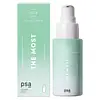What's inside
What's inside
 Key Ingredients
Key Ingredients

 Benefits
Benefits

 Ingredients Side-by-side
Ingredients Side-by-side

Water
Skin ConditioningDipropylene Glycol
HumectantGlycerin
HumectantPropanediol
Solvent1,2-Hexanediol
Skin ConditioningPentylene Glycol
Skin ConditioningAcrylates/C10-30 Alkyl Acrylate Crosspolymer
Emulsion StabilisingPolyglyceryl-10 Laurate
Skin ConditioningPolyglycerin-3
HumectantTromethamine
BufferingCapryloyl Salicylic Acid
ExfoliatingSodium Citrate
BufferingGlucosyl Hesperidin
HumectantCitrus Unshiu Peel Extract
MaskingDiethoxyethyl Succinate
SolventSodium Phytate
Panthenol
Skin ConditioningXanthan Gum
EmulsifyingHydrogenated Lecithin
EmulsifyingCetearyl Olivate
Sorbitan Olivate
EmulsifyingGlyceryl Acrylate/Acrylic Acid Copolymer
HumectantPvm/Ma Copolymer
Emulsion StabilisingSodium Hyaluronate
HumectantWater, Dipropylene Glycol, Glycerin, Propanediol, 1,2-Hexanediol, Pentylene Glycol, Acrylates/C10-30 Alkyl Acrylate Crosspolymer, Polyglyceryl-10 Laurate, Polyglycerin-3, Tromethamine, Capryloyl Salicylic Acid, Sodium Citrate, Glucosyl Hesperidin, Citrus Unshiu Peel Extract, Diethoxyethyl Succinate, Sodium Phytate, Panthenol, Xanthan Gum, Hydrogenated Lecithin, Cetearyl Olivate, Sorbitan Olivate, Glyceryl Acrylate/Acrylic Acid Copolymer, Pvm/Ma Copolymer, Sodium Hyaluronate
Water
Skin ConditioningGlycerin
HumectantCarthamus Tinctorius Seed Oil
MaskingPropanediol
SolventDimethyl Isosorbide
SolventGlucuronolactone
Skin ConditioningLeuconostoc/Radish Root Ferment Filtrate
AntimicrobialBisabolol
MaskingPolysorbate 20
EmulsifyingHyaluronic Acid
HumectantSodium Hyaluronate
HumectantSodium Hyaluronate Crosspolymer-3
HumectantSodium PCA
HumectantPanthenol
Skin ConditioningSaccharomyces/Xylinum/Black Tea Ferment
Skin ConditioningEuterpe Oleracea Fruit Extract
Madecassoside
AntioxidantGlycyrrhiza Glabra Root Extract
BleachingChondrus Crispus Extract
Skin ConditioningAllantoin
Skin ConditioningHydrolyzed Jojoba Esters
Skin ConditioningGluconolactone
Skin ConditioningSodium Lactate
BufferingSodium Gluconate
Skin ConditioningHydroxyethylcellulose
Emulsion StabilisingSodium Benzoate
MaskingSclerotium Gum
Emulsion StabilisingHydroxyethyl Acrylate/Sodium Acryloyldimethyl Taurate Copolymer
Emulsion StabilisingPotassium Sorbate
PreservativePhenoxyethanol
PreservativeWater, Glycerin, Carthamus Tinctorius Seed Oil, Propanediol, Dimethyl Isosorbide, Glucuronolactone, Leuconostoc/Radish Root Ferment Filtrate, Bisabolol, Polysorbate 20, Hyaluronic Acid, Sodium Hyaluronate, Sodium Hyaluronate Crosspolymer-3, Sodium PCA, Panthenol, Saccharomyces/Xylinum/Black Tea Ferment, Euterpe Oleracea Fruit Extract, Madecassoside, Glycyrrhiza Glabra Root Extract, Chondrus Crispus Extract, Allantoin, Hydrolyzed Jojoba Esters, Gluconolactone, Sodium Lactate, Sodium Gluconate, Hydroxyethylcellulose, Sodium Benzoate, Sclerotium Gum, Hydroxyethyl Acrylate/Sodium Acryloyldimethyl Taurate Copolymer, Potassium Sorbate, Phenoxyethanol
Ingredients Explained
These ingredients are found in both products.
Ingredients higher up in an ingredient list are typically present in a larger amount.
Glycerin is already naturally found in your skin. It helps moisturize and protect your skin.
A study from 2016 found glycerin to be more effective as a humectant than AHAs and hyaluronic acid.
As a humectant, it helps the skin stay hydrated by pulling moisture to your skin. The low molecular weight of glycerin allows it to pull moisture into the deeper layers of your skin.
Hydrated skin improves your skin barrier; Your skin barrier helps protect against irritants and bacteria.
Glycerin has also been found to have antimicrobial and antiviral properties. Due to these properties, glycerin is often used in wound and burn treatments.
In cosmetics, glycerin is usually derived from plants such as soybean or palm. However, it can also be sourced from animals, such as tallow or animal fat.
This ingredient is organic, colorless, odorless, and non-toxic.
Glycerin is the name for this ingredient in American English. British English uses Glycerol/Glycerine.
Learn more about GlycerinPanthenol is a common ingredient that helps hydrate and soothe the skin. It is found naturally in our skin and hair.
There are two forms of panthenol: D and L.
D-panthenol is also known as dexpanthenol. Most cosmetics use dexpanthenol or a mixture of D and L-panthenol.
Panthenol is famous due to its ability to go deeper into the skin's layers. Using this ingredient has numerous pros (and no cons):
Like hyaluronic acid, panthenol is a humectant. Humectants are able to bind and hold large amounts of water to keep skin hydrated.
This ingredient works well for wound healing. It works by increasing tissue in the wound and helps close open wounds.
Once oxidized, panthenol converts to pantothenic acid. Panthothenic acid is found in all living cells.
This ingredient is also referred to as pro-vitamin B5.
Learn more about PanthenolPropanediol is an all-star ingredient. It softens, hydrates, and smooths the skin.
It’s often used to:
Propanediol is not likely to cause sensitivity and considered safe to use. It is derived from corn or petroleum with a clear color and no scent.
Learn more about PropanediolSodium Hyaluronate is hyaluronic acid's salt form. It is commonly derived from the sodium salt of hyaluronic acid.
Like hyaluronic acid, it is great at holding water and acts as a humectant. This makes it a great skin hydrating ingredient.
Sodium Hyaluronate is naturally occurring in our bodies and is mostly found in eye fluid and joints.
These are some other common types of Hyaluronic Acid:
Learn more about Sodium HyaluronateWater. It's the most common cosmetic ingredient of all. You'll usually see it at the top of ingredient lists, meaning that it makes up the largest part of the product.
So why is it so popular? Water most often acts as a solvent - this means that it helps dissolve other ingredients into the formulation.
You'll also recognize water as that liquid we all need to stay alive. If you see this, drink a glass of water. Stay hydrated!
Learn more about Water